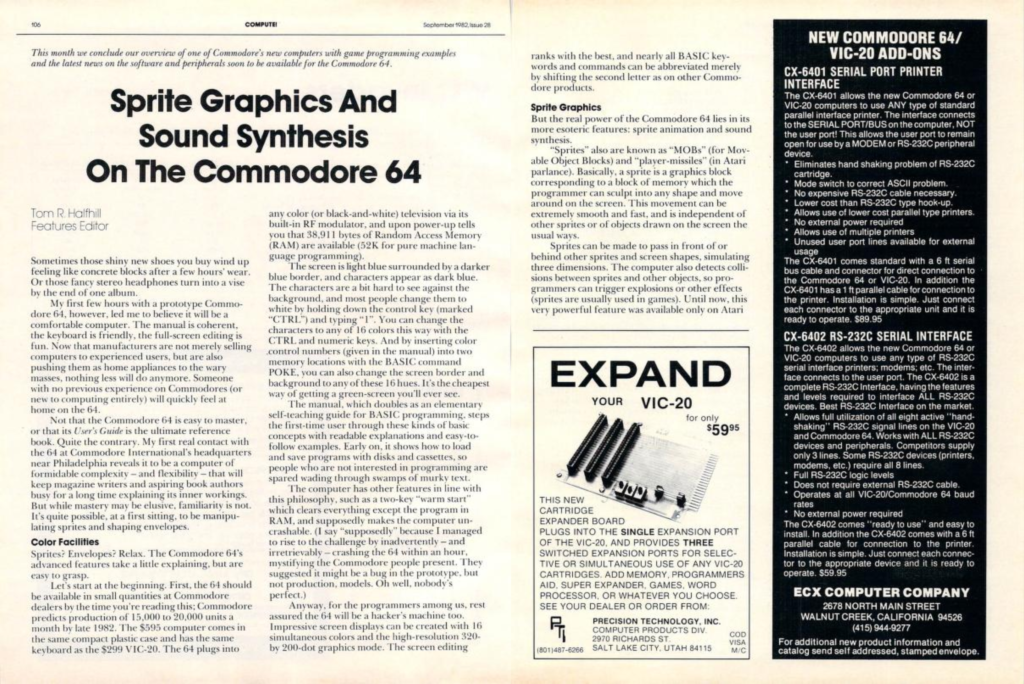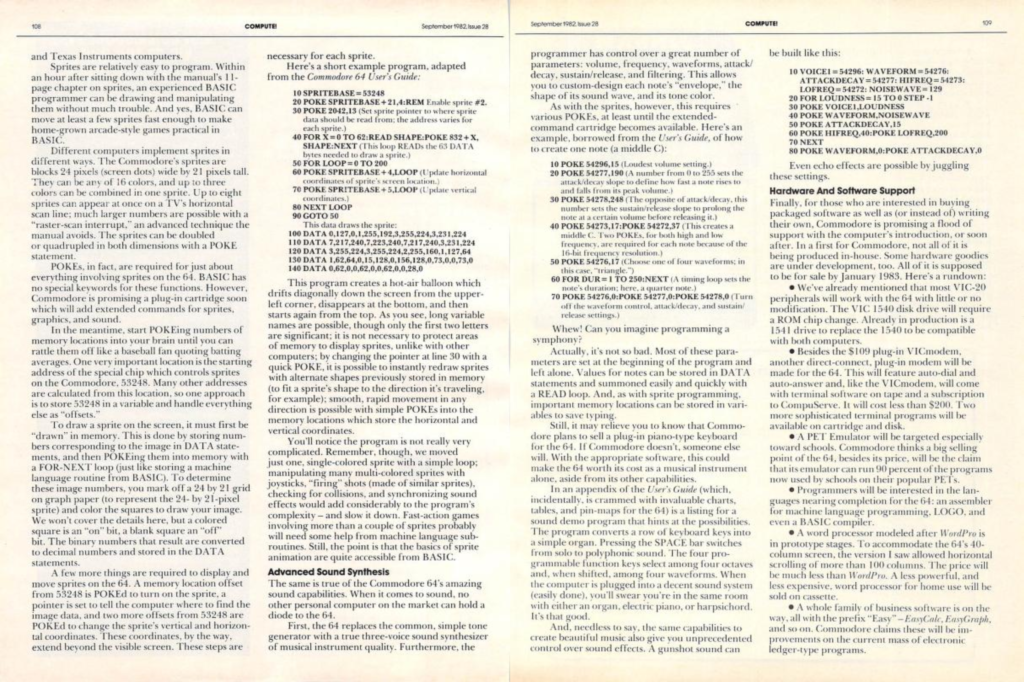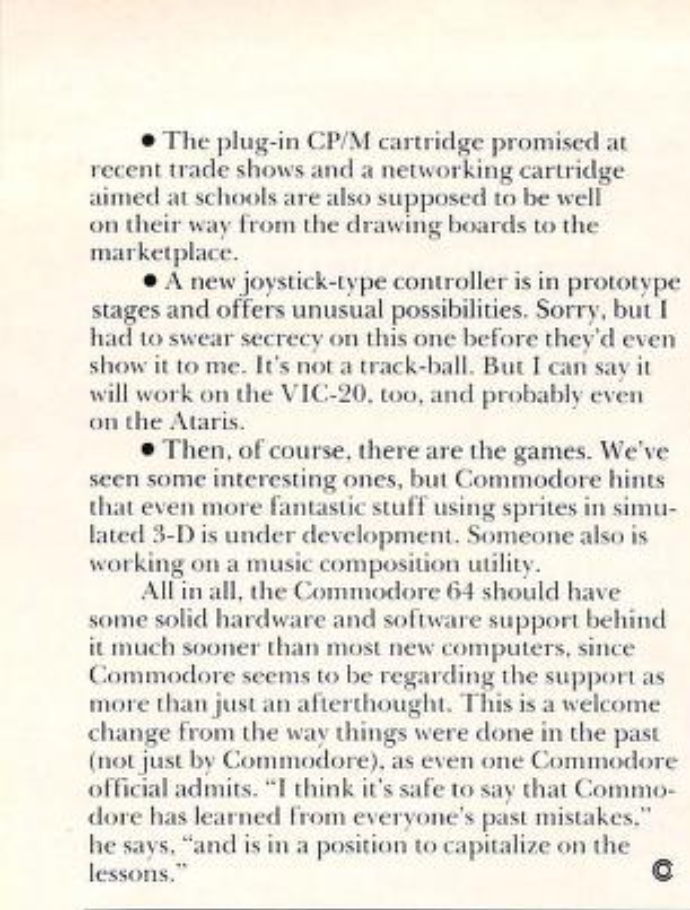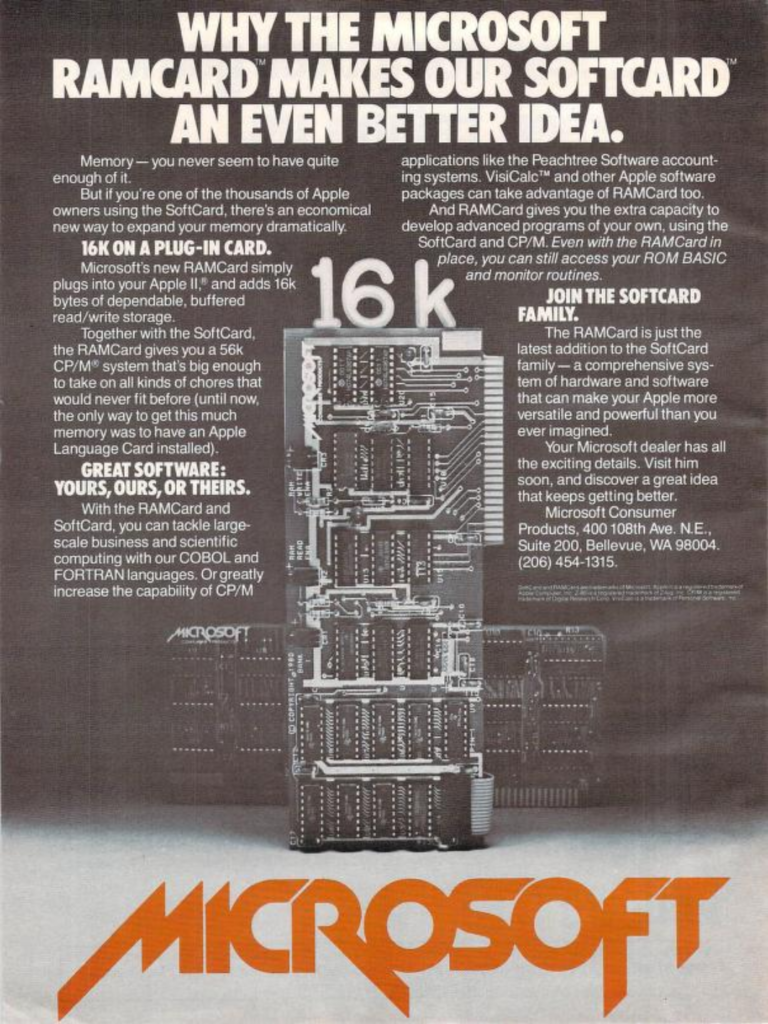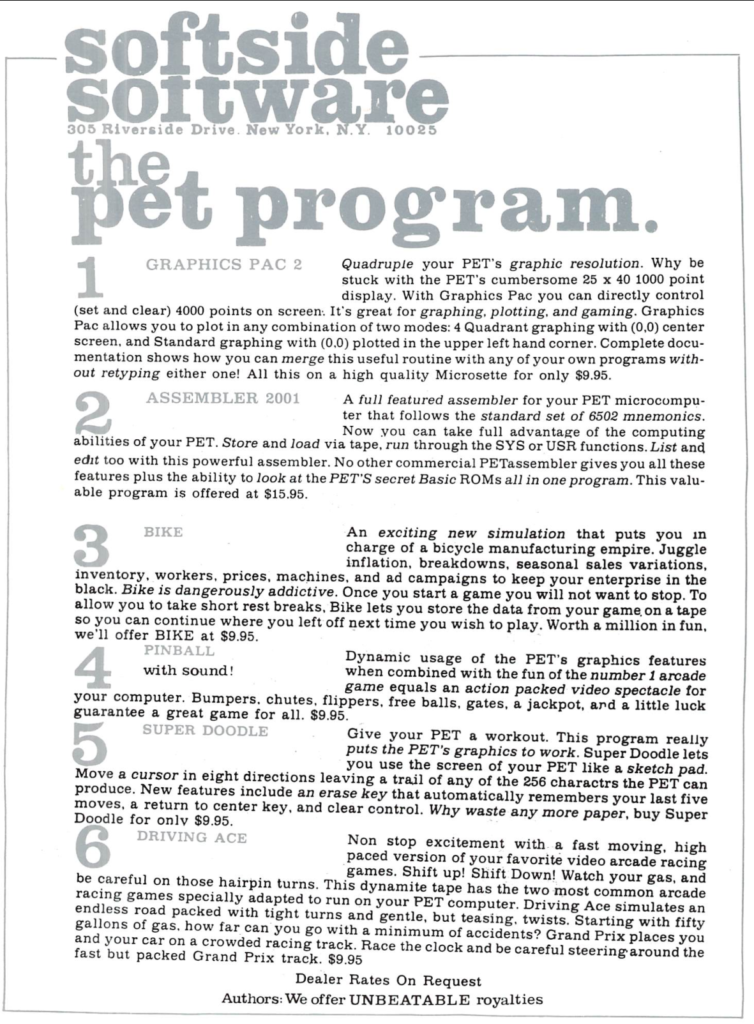
This is an ad, on the first page of the first issue of Compute Magazine, for “the pet program” from “softside software,” names all in lowercase. I have no idea if any copies of these programs remains in existence in our universe, but two places to look would be zimmers.net’s FTP archive and the Silicon PET Archive, and even in this era of the internet there are a fair number of PET software archives remaining.
Softside was far from the only company to put out its hopeful shingle through the pages of early computer magazines. At the time, magazine publishing worked with a lead time of several months. It is possible that Softside Software had gone under even by the time this ad saw print, but then again maybe not. A forum thread on AtariAge mentions several BASIC games sold by a “SoftSide,” apparently an Atari 8-bit magazine-on-disk, but they were based in New Hampshire, and the Softside of the ad was in New York.
Notes on the programs proffered:
- Graphics Pac 2: I’m not sure what they mean, as the reference I’ve found claims the PET didn’t have a bitmapped display, but there were several models, and further add-on cards that added bitmapped displays, an 80-column mode, and even (gasp) color. A simple “Microsette” itself would not be enough. We are near the end of the PET’s reign as Commdore’s core product though.
- Assembler 2001: It is easy to laugh this off nowadays when assemblers are mostly free software (and thank frog for that), but this was before that, and before the internet. $16 is a great price for an assembler from that time.
- Bike. Apparently it was a Hammurabi/Lemonade Stand style game, where you made business decisions through simple menus and entering figures. Maybe someday someone will write such a game about running Commodore. You might scoff at the warning that “Bike is dangerously addictive,” but standards were lower then. It was 1979; Wizardry wouldn’t be published until 1981. “Worth a million in fun, we’ll offer Bike at $9.95.” I admire their chutzpah.
- Pinball. “Dynamic usage of the PET’s graphics features” would have meant using its hardcoded, unchangable ROM graphics character set, with no sprites. “With sound!” That would mean its simple piezoelectric speaker. Don’t expect Raul Julia’s voice, or even Gorgar’s, to talk to you from the machine.
- Super Doodle. Certainly of no relation to Omni Software’s popular Commodore paint program. Super Doodle lets you use any number of colors so long as they’re black or green, and a resolution of 40×25 characters. “Why waste any more paper.” Well probably because loading your notes off of tape would take too long.
- Driving Ace. Offers two games for $9.95. The description doesn’t give a good sense of what they were like, but there are essentially only three kinds of racing game: scrolling in one direction (Monaco GP style), one screen or scrolling all around (Sprint style), and 3D (Pole Position through to Ridge Racer to F-Zero). I presume one of these is like Sprint and the other is like Monaco GP; I don’t think the PET was capable of even a slight approximation of 3D, but then, Pole Position’s hardware shouldn’t have been capable of what it could do either.
The ad is from Compute Magazine, most often stylized as COMPUTE! with an exclamation point, grew out of The PET Gazette in 1979. That former publication centered around the computing devices from Commodore International’s subsidiary, Commodore Business Machines. CBM had been around for over two decades up to that point as a maker of typewriters, adding machines and calculators, but in a maverick move by its co-founder and president Jack Tramiel, they bought MOS Technologies, which had just startled the nascent computing world by creating an ultra low cost microprocessor, the 6502. Tramiel had learned from a bit of a bastard move by Texas Instruments, who used their ownership of much of their supply chain to release a line of calculators that sold for less than Commodore’s production costs. Now, Tramiel owned the company that produced the chip that would soon launch the personal computing revolution, and could make other chips too, and Commodore was set to soon pull off Texas Instruments’ trick on the home computer industry with the VIC-20 and Commodore 64.
But until then they made other computers. They made the KIM-1 “single board computer,” and the PET 2001 and other machines with the PET branding. The PET Gazette’s audience was originally those machines, but burgeoning success convinced them to publish a more generalized 6502-focused magazine, and that magazine was Compute.
I have more to come on Compute, which in many ways was the archetypal type-in program magazine. It was far from the only one; other magazines offering type-in software at the time, names now even more obscure than Compute’s, were Creative Computing, Family Computing, and Commodore’s own publications Commodore Magazine and Power Play. Compute would for a while languish somewhat in the shadow of its own sister publication, borrowing part of its name from its predecessor, Compute’s Gazette, which focused on Commodore’s computers, the VIC-20, the Commodore 64, and later the Commodore 128.
The PET Gazette was founded by Small System Services Inc., and was published out of a shop, the Corner Computer Store, in Greensboro, North Carolina. Presumably that changed as the subscription rolls increased. Eventually Compute would be sold to ABC Publishing, a subsidiary of the broadcast network, and it would continue happily for several years. When its fortunes began to wane it was sold, first to Penthouse Publishing (really!), where its logo was redone to resemble that of its own publication Omni, then later to Ziff-Davis, who only wanted its subscriber list anyway; I don’t think they ever published an issue. As it became clearer that the future would be MS-DOS and Mac, its focus shifted, but they kept up their small systems focus for surprisingly long. I don’t think the Penthouse era provided any coverage that wasn’t DOS, Windows or Mac, but it would take time to check. Corrections later, if necessary.

